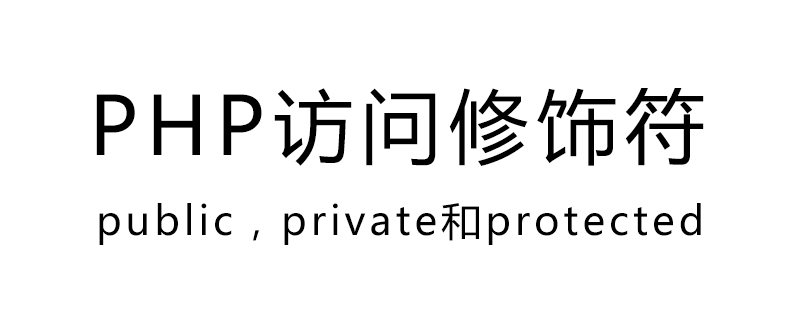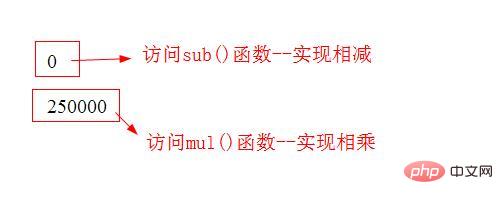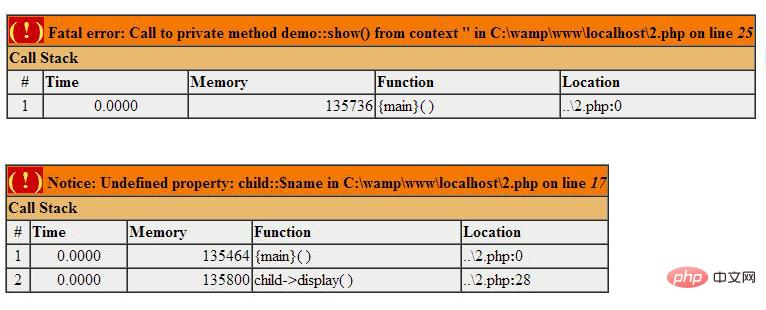A simple comparison of public, private and protected in PHP
There are three access modifiers in PHP: public, private and protected. You can define the visibility of properties, methods or constants by adding these keywords before the declaration. So what's the difference between them? Here is a brief introduction in this article, I hope it will be helpful to everyone.

PHP public access modifier
The public modifier can be used both internally and externally. If a class member is declared public, it can be accessed from anywhere. [Video tutorial recommendation: PHP tutorial]
Example:
<?php
header("content-type:text/html;charset=utf-8");
// BaseClass
class pub {
public $tag_line = "php中文网!";
function display() {
echo $this->tag_line."<br/>";
}
}
// 子类
class child extends pub {
function show(){
echo $this->tag_line;
}
}
// 对象声明
$obj= new child;
// 输出
echo $obj->tag_line."<br/>";
$obj->display();
$obj->show();
?>Output:

private access modifier
The private modifier can be used in the class in which it is defined and its parent or inherited classes. If a class member is declared protected, it can only be accessed within the class itself and from inheritance and parent classes.
Example:
<?php
header("content-type:text/html;charset=utf-8");
// 基类
class pro {
protected $x = 500;
protected $y = 500;
// 实现减法
function sub()
{
echo $sum=$this->x-$this->y . "<br/>";
}
}
// 子类-继承类
class child extends pro {
function mul() //实现乘法
{
echo $sub=$this->x*$this->y;
}
}
$obj= new child;
$obj->sub();
$obj->mul();
?>Output:

protected access modification The
#protected modifier can be used in the class in which it is defined. Note: It cannot be accessed outside the class means inherited classes.
If a class member is declared private, it can only be accessed by the class in which the member is defined.
Example:
<?php
header("content-type:text/html;charset=utf-8");
// 基类
class demo {
private $name="PHP中文网!";
private function show()
{
echo "这是基类的私有方法";
}
}
// 子类
class child extends demo {
function display()
{
echo $this->name;
}
}
// 对象声明
$obj= new child;
// 出现异常---未捕获错误:调用私有方法demo::show()
//$obj->show();
//出现异常--未定义的属性:子级::$name
$obj->display();
?>Output
 :
:
Explanation:
As you can see from the above example, it will show an error because private class data cannot be accessed outside the class.
The above is the entire content of this article, I hope it will be helpful to everyone's study. For more exciting content, you can pay attention to the relevant tutorial columns of the PHP Chinese website! ! !
The above is the detailed content of A simple comparison of public, private and protected in PHP. For more information, please follow other related articles on the PHP Chinese website!

Hot AI Tools

Undresser.AI Undress
AI-powered app for creating realistic nude photos

AI Clothes Remover
Online AI tool for removing clothes from photos.

Undress AI Tool
Undress images for free

Clothoff.io
AI clothes remover

AI Hentai Generator
Generate AI Hentai for free.

Hot Article

Hot Tools

Notepad++7.3.1
Easy-to-use and free code editor

SublimeText3 Chinese version
Chinese version, very easy to use

Zend Studio 13.0.1
Powerful PHP integrated development environment

Dreamweaver CS6
Visual web development tools

SublimeText3 Mac version
God-level code editing software (SublimeText3)

Hot Topics
 Working with Flash Session Data in Laravel
Mar 12, 2025 pm 05:08 PM
Working with Flash Session Data in Laravel
Mar 12, 2025 pm 05:08 PM
Laravel simplifies handling temporary session data using its intuitive flash methods. This is perfect for displaying brief messages, alerts, or notifications within your application. Data persists only for the subsequent request by default: $request-
 cURL in PHP: How to Use the PHP cURL Extension in REST APIs
Mar 14, 2025 am 11:42 AM
cURL in PHP: How to Use the PHP cURL Extension in REST APIs
Mar 14, 2025 am 11:42 AM
The PHP Client URL (cURL) extension is a powerful tool for developers, enabling seamless interaction with remote servers and REST APIs. By leveraging libcurl, a well-respected multi-protocol file transfer library, PHP cURL facilitates efficient execution of various network protocols, including HTTP, HTTPS, and FTP. This extension offers granular control over HTTP requests, supports multiple concurrent operations, and provides built-in security features.
 Build a React App With a Laravel Back End: Part 2, React
Mar 04, 2025 am 09:33 AM
Build a React App With a Laravel Back End: Part 2, React
Mar 04, 2025 am 09:33 AM
This is the second and final part of the series on building a React application with a Laravel back-end. In the first part of the series, we created a RESTful API using Laravel for a basic product-listing application. In this tutorial, we will be dev
 Simplified HTTP Response Mocking in Laravel Tests
Mar 12, 2025 pm 05:09 PM
Simplified HTTP Response Mocking in Laravel Tests
Mar 12, 2025 pm 05:09 PM
Laravel provides concise HTTP response simulation syntax, simplifying HTTP interaction testing. This approach significantly reduces code redundancy while making your test simulation more intuitive. The basic implementation provides a variety of response type shortcuts: use Illuminate\Support\Facades\Http; Http::fake([ 'google.com' => 'Hello World', 'github.com' => ['foo' => 'bar'], 'forge.laravel.com' =>
 12 Best PHP Chat Scripts on CodeCanyon
Mar 13, 2025 pm 12:08 PM
12 Best PHP Chat Scripts on CodeCanyon
Mar 13, 2025 pm 12:08 PM
Do you want to provide real-time, instant solutions to your customers' most pressing problems? Live chat lets you have real-time conversations with customers and resolve their problems instantly. It allows you to provide faster service to your custom
 Notifications in Laravel
Mar 04, 2025 am 09:22 AM
Notifications in Laravel
Mar 04, 2025 am 09:22 AM
In this article, we're going to explore the notification system in the Laravel web framework. The notification system in Laravel allows you to send notifications to users over different channels. Today, we'll discuss how you can send notifications ov
 Explain the concept of late static binding in PHP.
Mar 21, 2025 pm 01:33 PM
Explain the concept of late static binding in PHP.
Mar 21, 2025 pm 01:33 PM
Article discusses late static binding (LSB) in PHP, introduced in PHP 5.3, allowing runtime resolution of static method calls for more flexible inheritance.Main issue: LSB vs. traditional polymorphism; LSB's practical applications and potential perfo
 PHP Logging: Best Practices for PHP Log Analysis
Mar 10, 2025 pm 02:32 PM
PHP Logging: Best Practices for PHP Log Analysis
Mar 10, 2025 pm 02:32 PM
PHP logging is essential for monitoring and debugging web applications, as well as capturing critical events, errors, and runtime behavior. It provides valuable insights into system performance, helps identify issues, and supports faster troubleshoot






